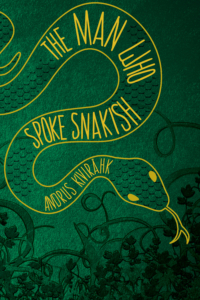[Grove Press; 2015]
Tr. by Christopher Moseley
A folk fantasy novel translated from Estonian by Christopher Moseley, The Man Who Spoke Snakish by Andrus Kivirähk envisions the coming of German-speaking Christians to the far woods of medieval Estonia and a young man’s response to the rapid disappearance of his way of life. Still versed in the ancient tongue of Snakish, a language humans share with adders, Leemet and his family can control the other animals of the forest with a sibilant command. Through a humorous critique of the logic of transitioning from a hearty hunter-gatherer lifestyle to the toil of farming grain and living in a village, the novel questions the automatic adoption and adoration of newfangled foreign systems and wonders why we give up one way of life for another. Frequently ridiculing the gruel-dulled wits and thickened tongues of the villagers and the accepted gluttony of the monks and “iron men,” The Man Who Spoke Snakish depicts the self-deception and forgetting that are integral to this change of cultures. As people lose their ability to understand Snakish, the snakes begin to attack these voiceless blunderers. What information and relationships have we lost, the novel asks, because we forgot how to listen?
Rather than depicting one or the other culture as universally better than the other, the novel examines how the same nonsensical practices transition into the new setting, simply with different trappings, just as the people exchange a forest name for a Christian one. The paganism of the old ways flows into the superstitions of the new ones, each dominated by elders lacking any of the wisdom that is meant to accompany their grey hairs. Deeply anti-religious, the novel questions society’s ability to believe one set of mystical explanations while rejecting behaviors as primitive that have directly enabled their survival for generations, asking: Why should the Pope know more about Estonia than Estonians?
As almost every other family gives in to the allure of foreign practices and finery, Leemet’s mother moves back into the woods from the village because she simply can’t abide bread. Why strive for a barklike sponge when fresh venison is only a hiss away? Yet this move against the social tide leaves Leemet to grow up more in the company of snakes than humans. Simultaneously seeking to revive the myths of old and turning into a myth himself, Leemet’s shifting interactions with his decaying world explore the emotions of someone who lives on the border of changing times. Whether he is hiding in the thickets at the wood’s edge to spy on the pretty village girls or tearing across the countryside to revenge his lost future, Leemet finds life on the fringe constantly unraveling.
Given that the novel represents a dying community, it is not as overpopulated with peripheral characters as fantasy novels tend to be. Those that it does describe are quirky and vivid, if not particularly nuanced. As some people retreat, some convert, some battle, and some go mad in the face of change, the complexity depicted is more between the characters than within them. Several characters also mark the ways in which time overlaps. For example, two of Leemet’s friends, the ape-like “Primates,” are from an age even farther back than his own, without clothing or complex tools. Rather than adopting the new materials of Leemet’s hunting-based culture, the Primates become ever more conservative in keeping to the traditions of their time — a time that no longer exists for anyone else. These and other unreproductive stragglers do not go gently from the world: they leave with armies of lice and chalices carved from the skulls of defeated moderns.
Although perhaps no more so than many other fantasy books, The Man Who Spoke Snakish depicts an increasing level of brutality as its pages continue, concluding in a rampage that leaves Leemet encrusted in the dried blood of his enemies. Death leaps from the shadows all too often. Also like many other fantasy novels, the women in this story range from underwhelming to obnoxious, sexualized and obsessed with feeding people. Only the adder Ints shows any satisfying degree of character. Yet the deficiencies of these women seem less a characteristic of their sex than a result of their context. Ints and the female Primate are almost genderless in their strong characterizations, while the increasingly modern contexts impose progressively restrictive and subordinate positions on women. Leemet repeatedly wonders at the propensity of the villagers to blithely rationalize their unequal status and to seek out opportunities to become the servant or bedfellow of foreign knights and monks.
Rather than following what his fellow humans see as becoming “smarter,” Leemet holds to and bemoans the loss of an older wisdom. He laments how quickly his fellow humans lose their ability to speak Snakish, to communicate with animals of the forest, and to live independently. Although the forest dwellers move to the village in hopes of a better, more modern life, we actually see them shrunken with malnourishment, abused by religious and military powers, and made ridiculous by superstition. Leemet’s childhood friend Peetrus becomes the most honored member of the village because he is the first of them to be taken as a knight’s manservant to fight in the Crusades. How quickly he has shifted from being born a pagan himself to going across the world to convert and destroy others, and likely to be killed himself.
This novel slithers along like the snakes it so admires, agile and often unexpectedly compelling. Although I never paused to wonder at the beauty of a sentence, its irreverence for convention flows charmingly from its conversational prose. Kivirähk’s novel proved profoundly successful in his home country, even leading to the creation of a board game. Admittedly, I’d never read anything written by an Estonian or set in Estonia, so this was itself a fascinating element of the story for me. Readable and engaging, it’s easy to see how this novel could become the delight of a nation.
Emma Schneider is a graduate student at Tufts University. Her research focuses on North American and Environmental Literature.
This post may contain affiliate links.








